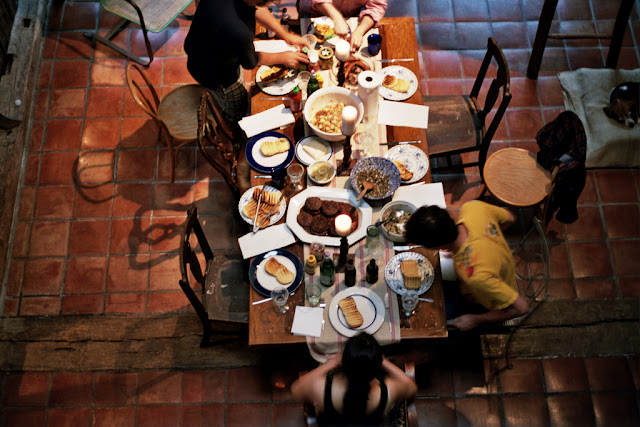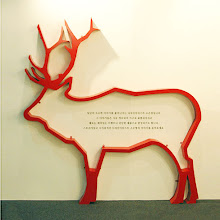 |
| Supermarkets have made farming big business and this has caused some serious concern about the journey our food goes on to get too our plate. With so many horror stories out there it’s very hard for us the consumer to trace the origins of our ingredients. This insecurity has created a surge in “urban homesteads” where people live a self-sufficient, low-impact life in the heart of the city. |
 |
| Buying local produce has become hugely important for many. Vegetable box schemes are run on a local or regional basis, delivering food direct from the producer to the consumer. In 2007 this industry was worth in the UK an excess of £100 million per-annum. However, for many people this scheme is limiting because the contents are not ordered by the customer, but are selected by the box scheme provider on the basis of seasonality and availability. Photo by Brian W Ferry |
 |
| City Dwellers are opting away from pretty flower beds and choosing roof-top vegetable patches to window-box herb gardens. Lady watering her garden by Subaonet; This New York man demonstrates on Urban Organic Gardener how he has overcome his small living space by growing his vegetables on his fire escape. Fact is most people across the globe don't have large backyards and many of us use our balconies for outdoor living. Photo from Mangalorean Recipes. |
 |
| Sadly a supermarket tomato has declined in taste and the reason is commercialisation. The commercial grower has learned how to grow tomatoes which crop heavily and will travel well to the supermarket at the expense of taste. A homegrown tomato bursts with flavour and relatively easy to grow. Photo by Gardeners Guide |
 |
| Sustainability is important to the "Urban Homesteader" and are constantly looking for resourceful solutions for their family to have less impact to the environment. Photo by Michelle Anderson |
 |
| Designers are becoming fascinated with urban farming and developing products including 'Cultivation Cabinets' - a cupboard in which young edible plants can be grown - such as the one by Bureau Marije van der Park and Maarten Kolk & Guss Kusters. By placing the process of growth into an interior product designers are encouraging us to bring vegetation back into our daily life. |
 | |
| Designers are looking at how we can preserve food without a refrigerator. Photo byAntipodese |
 |
| Hot Japanese brand Billet inject beautiful basics into their range with canvas bags. We are seeing popularity in the kitchen larder to store our food. Kitchen brand bulthaup included drawers in their b3 collection to stock root vegetables that keep better in dark, cool spaces. "Observing the food and therefore changing the notion of food preservation, we could find the answer to current situations such as the overuse of energy and food wastage. My design is a tool to implement that knowledge in a tangible way and slowly it changes the bigger picture of society. I believe that once people are given a tool that triggers their minds and requires a mental effort to use it, new traditions and new rituals can be introduced into our culture," explains Jihyun Ryou who designed in 2009 products "Save Food From the Refrigerator". Just like the popularity in people sharing photographs on the web of their home and fashion style people are snapping the vegetables they are growing and the food they are cooking. Popular food blogs are Sweet Paul, Oh Joy and my fiance's blog The Foodie. Photo by Molly Wizenberg. |
 |
| The "urban farmer" does not only grow vegetables at home. It has become clear one of the large areas of cruelty is mass chicken farming which has affected the quality of the product. Photo of girl reading by (Ku)Nihito ; Egg photo by Abbey Powell |
 |
| The local-food movement, in cities from Seattle to London have flocked to the idea of small-scale backyard chicken farming—mostly for eggs, not meat—as a way of taking part in home-grown agriculture. At Design Miami in 2008 German creative director Mike Meiré designed the The Farm Project for luxury kitchen and bathroom brand Dornbracht, The Farm Project is based on a rustic farmhouse kitchen, in deliberate counterpoint to today’s ubiquitous minimalist look. Urban chickens are getting sculptureally cool coops such as The Nogg by Matthew Hayward and Nadia Turan. |
 |
| Designer Jihyun Ryou designed hanging storage for eggs which can be checked for freshness by simply placing an egg in the glass of water built into the system to see if it sinks to to the bottom. Rooftops have become popular places to keep chicken coops. |
 |
| After watching Hugh Fearnley-Whittingstall, the Big Fish Fight that championed a neglected cause: the sustainable use of fish from the seas and the misleading labeling supermarkets are providing on their packaging it's not surprising to find people farming their own edible fish. Edible fish displayed in aquarium at the The Farm Project |
 |
| Designers are looking at how we can humanely breed and keep edible fish. Fish photo by Mikkel Vang. Home Farming, as the name suggests, explores growing at least part of your daily food inside your house. "People are increasingly concerned about how their food has been manipulated and processed, genetic modification, global shortages, environmental degradation through monoculture, the distance food travels before reaching their plates and many other related issues," says Clive van Heerden, Senior Director of design-led innovation at Philips Design. “One way of addressing such legitimate concerns is to source the food yourself by having a biosphere in your living room.” The Food Probe by Philips Design is a biosphere home farm containing fish, crustaceans, algae, plants and other mini-ecosystems, all interdependent and in balance with each other. Making families all over the world at least partly self-sufficient in this way has obvious appeal. Farm in a Box is by Earth Solutions |
 |
| Homeowners are giving up outside space to ponds to farm fish. Photo by Sean Yea |
 |
| Electrical specialist Comet claims there is 57% year-on-year increase in sales of breadmakers as consumers look for ways to cut their weekly shopping bills. However as many of our kitchens are too small to store breadmakers many are baking bread from scratch. Making dough photo by Molly Wizenberg; Bread baked in Le Cruset pot photo by Mel Hunter. |
 |
| Using simple, old-fashioned techniques like curing meats and canning and drying fruits and vegetables are being rediscovered by city folk to prevent food wastage in their home. Photo by Abby Powell |
 |
| Consumers are becoming much more interested in the origins of their food and how it got to their table. A relatively new scheme is Adopt-a-Pig, where you can track your pig's life from start to finish ... from pasture to plate. Photo by Photo by Molly Wizenberg. |
 |
| ~ Choose pig - Name Pig - Visit Pig - Eat Pig. Photo by Molly Wizenberg. |
 |
| Nowadays, food provenance is a big issue so it understandable why the modern kitchen has stepped away from gizmos and gadgets and concentrating on ideas that can produce healthy ingredients for our families to consume. After watching Jamie Oliver's American Food Revolution and how city school children couldn't identify a potato it's no wonder why this way of living is becoming so important to people. For many urbanites it's their real path to freedom. Photo by Molly Wizenberg. You can read more on this subject here and here. |








I am Loving your Blog! And we love our veg garden . . .
ReplyDelete"Choose pig - Name Pig - Visit Pig - Eat Pig" - for us, I don't think so . . . It will be Choose Pig, Name Pig, Love Pig, Pig Die of Old Age one day . . . haha!
LOL.. I am exactly the same :-) However I do have friends who have done the scheme and rave about it. You should send in a picture of you and your garden for "what I did this weekend" x
ReplyDeleteThis is stunning - visually and thoughtfully.
ReplyDeleteAmazing!
ReplyDeletePatricia